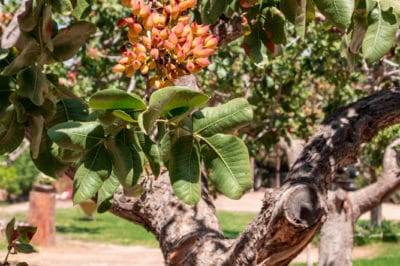Pistachio Leaves
Pistachios trees have compound leaves with three to five rounded, deep-green leaflets opposite each other along a central stem. Each leaflet measures between 2 and 4 inches long. At the base of each leaf (not leaflet) is a bud that become a cluster of flowers the following spring. By November, the trees shed their leaves in preparation for winter dormancy.
Expert gardener’s tip: The leaves of pistachios growing in nitrogen-deficient soil turn red between their veins.
Pistachio Flowers
Pistachio trees are male or female. Both bloom in clusters, with each cluster having 13 branches and each branch producing from five to 19 tiny, greenish-brown flowers. None of the flowers have petals; males have five pollen-producing stamens and females single ovaries. They rely on wind for pollination, so only about 1 in 10 females develops a harvestable nut.
Pistachio Fruits
Pistachio fruits hang in grapelike clusters from the ends of their branches. In heavy-crop years, the weight of the fruit may force the branches to bend toward the ground. Botanically known as drupes, each fruit consists of:
- The exocarp, or red-tinged, greenish-yellow outer husk
- The mesocarp, or fleshy green middle layer
- The endocarp, or creamy white shell enclosing the nut
Unless you grow them, however, the only time you’re likely to see an intact pistachio drupe is right after it’s harvested. Processing removes both the outer layers.
Pistachio Nuts
The most colorful part of a pistachio nut is the thin hull separating its kernel and shell. As the kernel ripens, its shell starts opening and the hull darkens from yellow to trademark pistachio green. At harvest time, the mature nut resembles a partially open mussel and the hull is rosy red.
Expert gardener’s tip: The timing of shell split depends on where a pistachio grows in USDA zones 7 through 10.
Other Features
As pistachio trees mature, their smooth, pale-gray bark darkens and cracks. Fully grown trees typically stand from 25 to 35 feet tall, with a bushy form and dense, umbrella-shaped canopies. Female trees are smaller than males. But their best-kept secret may be their remarkable wood. It ranges in color from pale olive to orangey- or purplish-brown, with strikingly irregular brown or black graining.
